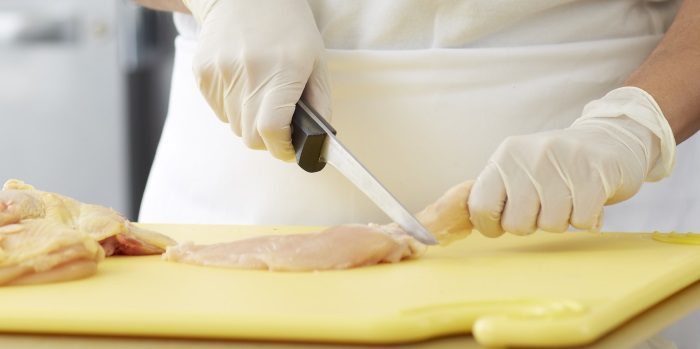National Food Safety Month Week 3: Prepare food safely
 Never use the same food-contact work surface without cleaning and sanitizing it between foods.
Never use the same food-contact work surface without cleaning and sanitizing it between foods.Cross-contamination is the transfer of pathogens from one surface or food to another, and it can happen at almost any point in the flow of food through your operation. However, when you know how and where it could happen, it’s easy to prevent.
To extend your Food Safety Month experience, visit our resources page to download posters, activity sheets, and more!
Here are six tips from the National Restaurant Association ServSafe team to help you prevent cross-contamination.
1. Keep contaminated food out of the operation during receiving
- Make sure food packaging is intact and clean. Reject food that’s dirty, water-stained, leaking, or discolored
- Make sure packaging is free of holes, tears, punctures, or other types of damage
- Reject cans that are dented, rusty, or have swollen ends
- Reject items if you see signs of pests
2. Store food in ways that prevent cross-contamination
- Store food in designated food-storage areas
- Store food away from walls, and at least 6 inches off of the floor
- Wrap or cover food before storing it. This could stop contaminants from falling into food
- Only store food in containers intended for food
- Store raw and ready-to-eat foods separately if possible
- If you can’t store foods in separate storage areas, store food in the following top-to-bottom order; it’s based on the minimum internal cooking temperature of each food:
- Ready-to-eat food
- Seafood
- Whole cuts of beef and pork
- Ground meat and ground fish
- Whole and ground poultry
3. Prepare food in ways that prevent cross-contamination
- Make sure workstations, cutting boards, equipment, and utensils are clean and sanitized before use
- Don’t allow ready-to-eat food to touch surfaces that have come into contact with raw meat, seafood, or poultry
- If you’re using the same worktable, schedule when you prepare raw meat, seafood, and poultry at different times than when you’re preparing ready-to-eat food
- Clean and sanitize work surfaces, utensils, and equipment between each food product
4. Serve food in ways that prevent cross-contamination
If food comes into direct contact with a surface, it’s considered a food-contact surface. Many of the utensils and equipment you use have food-contact surfaces—plates, glasses, forks and tongs are examples. You can contaminate these surfaces if you’re not careful when handling them.
- Do NOT touch dishes, glassware, or utensils by the parts that come into contact with food, such as the interior or rim of a glass, tine-end of a fork, or inside of a bowl
- Hold dishes from underneath or on the edge; glasses by the middle, bottom, or stem; and flatware by the handles
- Do NOT use bare hands to handle ready-to-eat food; use tongs, deli sheets, or gloves
- Never scoop ice with your bare hands
- Use utensils properly and never use the same utensils when handling ready-to-eat food and raw meat, poultry, or seafood
- Use separate utensils when serving different food items
- Store serving utensils in food with the handles extended beyond the rims of the containers
- Cover food to protect it from contaminants
- Never use towels you’ve cleaned food spills with for any other purpose
5. Store utensils and equipment in ways that prevent cross-contamination
Utensils and equipment with food-contact surfaces, such as cutting boards, must be stored in ways that prevent contamination. The same is true for nonfood items such as napkins, plastic forks and knives.
- Store utensils and equipment that touches food at least 6 inches off of the floor
- Store glasses and cups upside down on a clean and sanitized surface
- Store utensils with handles up
6. Protect guests with allergies from allergic reactions
Kitchen and serving staff must do their part to avoid serving food that contains allergens to people with food allergies. Here are some things you can do:
- Learn which foods commonly cause allergic reactions. They include milk, soy, eggs, wheat, fish, crustacean shellfish, peanuts, and tree nuts
- Identify items on your menu that contain allergens for your guests
- Be prepared to tell guests how items are prepared
- Clearly identify allergen special orders for the back-of-house staff
- Check recipes and ingredient labels to confirm that the allergen is not present
- Clean and sanitize cookware, utensils, and equipment before preparing food for customers with allergies
- Wash your hands and change gloves before prepping food
- Make sure the allergen doesn’t touch anything for customers with food allergies